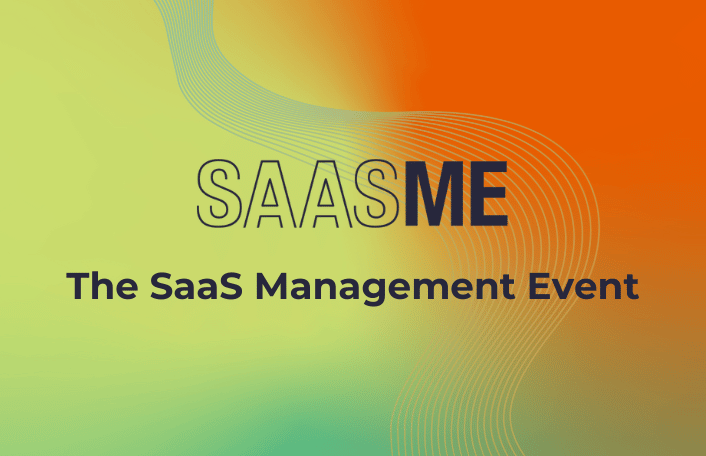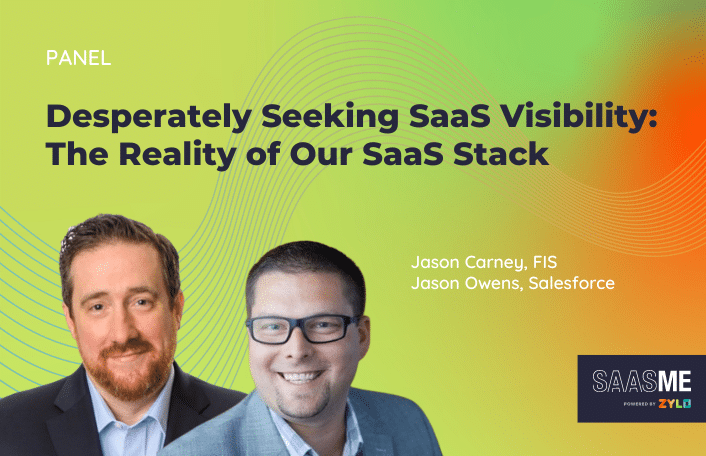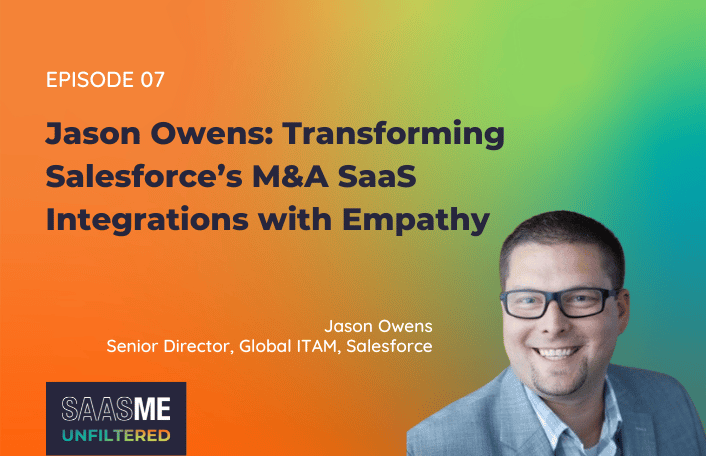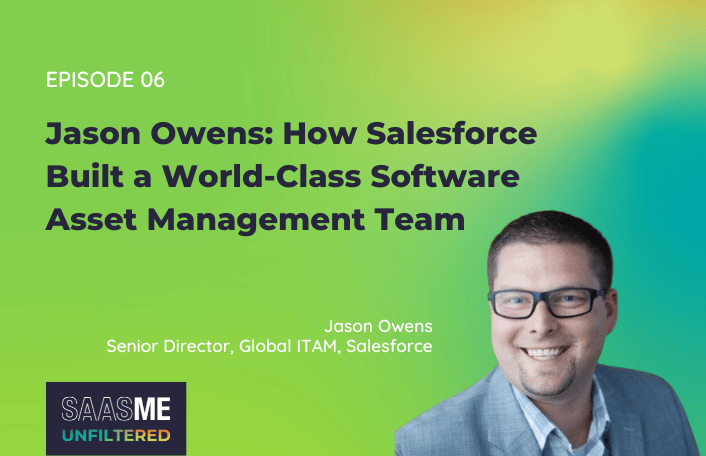
5 Takeaways from SaaSMe 2023
Table of Contents ToggleSaaSMe 2023 Takeaway #1: You Really Don’t Know...
Back
Back
Search for Keywords...
Blog

05/30/2023
Table of Contents
How large is your organization’s SaaS portfolio? You likely don’t know. And, frankly, that’s a huge problem. You can’t manage what you don’t know exists. In fact, the average organization has a lot of gaps, underestimating the size of their SaaS portfolio by 2 to 3 times. We see this with most of our customers, so know that you and your organization are not alone.
At SaaSMe 2023, we invited a panel of SaaS professionals who were recently in your shoes to share their experience and knowledge unlocking the full visibility of their SaaS footprint. Being able to see and understand how big your SaaS footprint really is allows you to drive organization-wide impact through your SaaS investments.
This panel’s speakers included:
While there were many fascinating insights shared over the course of the panel, there were a few key takeaways – sound advice for any business with a SaaS portfolio. Here are what Jason Carney and Jason Owens (“the Jasons”) identified as the most important elements of looking at your SaaS stack.
Both Jasons identified cost as a primary driver for the need to improve SaaS stack visibility. Surprisingly, there are many places where businesses can incur extra costs related to software.
“I think the surprising part is just how many of everything we have,” said Jason Carney.
First, businesses are not taking advantage of economies of scale and standardization of enterprise agreements. Individual software licenses can cost as much as six times the price per head as corporate licenses. So, tracking down these extra licenses can be key to reducing your SaaS spend.
This is not necessarily an easy process, because it can interfere with office culture and productivity if people think they need a specific tool to facilitate their job. But with some work and the encouragement of a cultural management shift, you can help standardize the software your employees use.
Another key to keeping costs low is getting started with software asset management visibility early. When you start keeping an eye on your SaaS platform when you’re in the small, 50-200 employee range, you can build best practices. You can build software standardization into the company, and you won’t find yourself in a situation where you have 85,000 employees and serious SaaS sprawl.
As an organization, it’s important to have a healthy tension between security, data protection, and cost. There must be strong checks in place on what sites are accessed, what data is uploaded, and where money is spent. When it comes to SaaS risk, you don’t want to leave a door unattended or unlocked.
Gone are the days where IT and asset managers simply throw employees at security problems. Today’s data security is smarter and requires companies to do more with more process and procedure rigor, tooling, and automation.
Then there’s the issue of shadow IT. Your ability to identify and mitigate shadow IT risks can improve your organization’s overall security posture and reduce the risk of financial losses due to data breaches or other security incidents.
Finally, an enterprise that loses significant funds to SaaS sprawl puts itself at financial risk. Jason Owens noted this among the recent changes at Salesforce.
“I think one of the things that we don’t often talk about is that there is significant enterprise risk in the spend itself. It’s not just the risk of the dollars. It’s the risk that comes along with the dollars.” Said Owens.
The company’s targets are increasing over the next few years, and Zylo is an important part of how they make improvements going forward.
Another key issue that many businesses face is redundancy with their software subscriptions. With the ease of purchasing across the business, it’s easy to have a significant amount of software that you don’t actually use.
For Jason Carney at FIS, “It’s 41 different project management apps. It’s 17 different UI/UX tool sets… It’s 37 different collaboration tools.”
If this is the case for you (and it likely is), Carney recommends that you have a meeting with your organization’s architect or enterprise architecture board to examine the problems together. Look at your renewal roadmap to understand why you have so many apps in the first place. Then, put them through a rationalization process.
Start by examining your software and determine which applications should be retired and which should be retained. Sometimes there are genuine reasons for a business to have seemingly redundant software. It may be a question of having one tool that does a lot of things okay or having multiple tools that can integrate but are best in class.
Other times, there are places where your business can save significant amounts of money by reducing the amount of licenses you renew. You may have significant multi-year licenses that you can leverage to drive usage to a primary tool.
If your employees and lines of business are willing to change, that can be a catalyst to standardizing apps as a primary or secondary tool. It can be difficult to eliminate software, but it is often the right thing to do for your business.
It’s important to note that these decisions don’t happen overnight. Instead, mindfully create a rationalization plan that can roll out over time. From a financial perspective, creating a multi-year roadmap for rationalization can reduce your threat surface. It standardizes the user experience, reduces the number of platforms where employees are opening help tickets, and creates a long tail of potential savings that can get ignored because businesses like to go for the hard dollars first.
Once you see your portfolio and understand what’s in it, you can leverage SaaS visibility to drive organization-wide impact on your business’s financial performance. By identifying redundant or underutilized SaaS applications, you can streamline your technology investments and reduce costs.
The bottom line is that visibility is the key to SaaS management. Organizations underestimate the number of applications – and how much they need to spend – by 2 to 3 times the actual amount. As Jason Owens and Jason Carney can attest, it’s impossible to manage what you can’t see.
These three points are only part of the wisdom shared at SaaSMe this year. If you want more key insights into SaaS management and how reducing your SaaS sprawl can improve your business, you can watch the whole session on-demand right here!

Table of Contents ToggleSaaSMe 2023 Takeaway #1: You Really Don’t Know...

Table of Contents ToggleEpisode SummaryGuest SpotlightEpisode HighlightsEmbrace the Democratization of SoftwareEvangelize...

Table of Contents ToggleEpisode SummaryGuest SpotlightEpisode HighlightsCreate a Program that Pays...

Table of Contents ToggleCost Is the Primary Driver for VisibilityDon’t Overlook...
| Cookie | Duration | Description |
|---|---|---|
| cookielawinfo-checkbox-analytics | 11 months | This cookie is set by GDPR Cookie Consent plugin. The cookie is used to store the user consent for the cookies in the category "Analytics". |
| cookielawinfo-checkbox-functional | 11 months | The cookie is set by GDPR cookie consent to record the user consent for the cookies in the category "Functional". |
| cookielawinfo-checkbox-necessary | 11 months | This cookie is set by GDPR Cookie Consent plugin. The cookies is used to store the user consent for the cookies in the category "Necessary". |
| cookielawinfo-checkbox-others | 11 months | This cookie is set by GDPR Cookie Consent plugin. The cookie is used to store the user consent for the cookies in the category "Other. |
| cookielawinfo-checkbox-performance | 11 months | This cookie is set by GDPR Cookie Consent plugin. The cookie is used to store the user consent for the cookies in the category "Performance". |
| viewed_cookie_policy | 11 months | The cookie is set by the GDPR Cookie Consent plugin and is used to store whether or not user has consented to the use of cookies. It does not store any personal data. |
